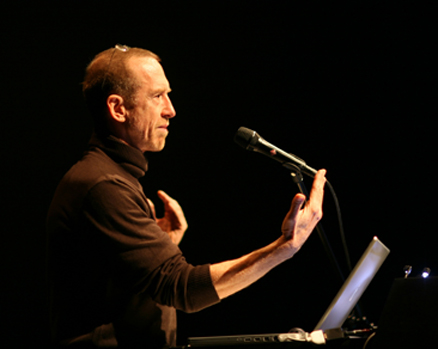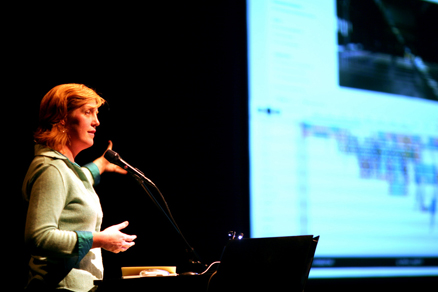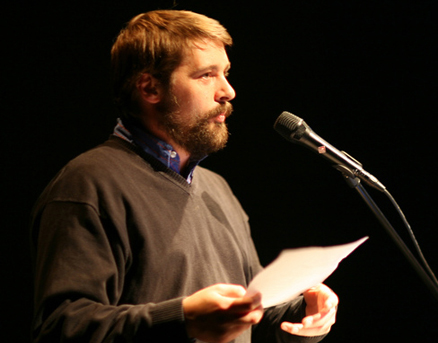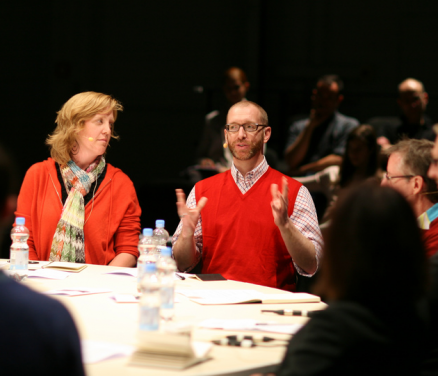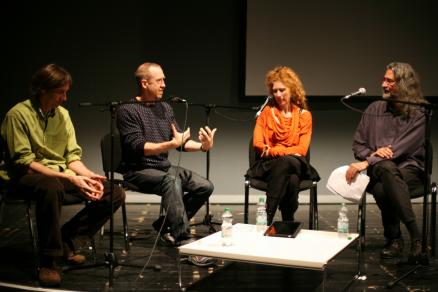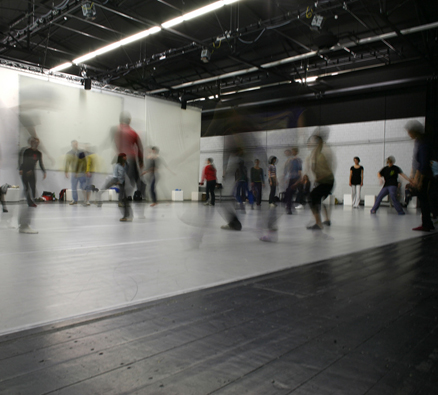Introducing Motion Bank
Introducing Motion Bank& education workgroup meetingIntroducing Motion Bank (5-7 November 2010) was organised to inform the public about the inspiration behind the project and to introduce them to the researchers, designers, artists and educators involved. Staged at The Frankfurt Lab, the event included presentations, round table discussions and workshops. It began Friday evening with a large gathering in the Frankfurt Lab Halle to hear William Forsythe, Christopher Roman, Norah Zuniga Shaw, Nik Haffner, Heiner Blum, Alva Noë and others introduce themselves and their relationship to the project. |
|
|
Both William Forsythe and Norah Zuniga Shaw talked about the development of Synchronous Objects for One Flat Thing, reproduced (the prototype project for Motion Bank which they collaborated on creating) and the research questions that motivated that project such as “How can we teach audiences to see complex choreographic organisation?” Nik Haffner (one of the co-developers of the Improvisation Technologies CD-Rom) gave a brief practical demonstration of how to apply the tools offered by Synchronous Objects. |
|
|
Florian Jenett, Score Co-ordinator in Frankfurt, gave a short outline of the process they envisioned for working with the guest choreographers. He also said they were interested to see how the dance data itself might produce new kinds of ideas about the recorded dance. Philosopher & Motion Bank Research Associate Alva Noë summed up the evening with some words on how the creation, study and use of scores might help us understand not only dances but also human consciousness. Alva also introduced the Dance Engaging Science Interdisciplinary Workshops accompanying Motion Bank. |
|
|
One of the research aims of Motion Bank is to develop educational applications using the resources it produces in developing the on-line scores. On Saturday afternoon, Choreography in the Curriculum was staged as a conversation in public on how choreographic ideas are already incorporated into dance education. The round-table participants included Dieter Heitkamp, Gerald Siegmund, Kurt Koegel, José Biondi, Andrea Tallis, Nora Kimball, Nobert Pape, Nina Vallon, Kristina Veit, Norah Zuniga Shaw, Nik Haffner and was moderated by Christopher Roman. An informal meeting of the members of the International Education Workgroup was held on the Saturday morning to discuss interests and expectations. |
|
|
Saturday evening featured a presentation of Piecemaker with its developer David Kern followed by a dialogue with Forsythe and philosophers Erin Manning and Brian Massumi who were in-residence with Motion Bank at that time. Massumi opened the conversation commenting on the tensions inherent in trying to archive movement, especially complicated by the ‘doubly ephemeral’ aspect of choreography where movement is folded back into the process of making more movement. |
|
|
Video Impression: David Kern presenting Piecemaker which he initiated as a research project to support the organisation and recall of materials created by The Forsythe Company in the rehearsal studio. |
|
|
Video Impression: Brian Massumi describing how seeing movement might benefit from technological supplements... |
|
|
Interdisciplinary work is at the heart of Motion Bank’s enquiry into the nature of choreographic practice not only as shown in the collaboration between choreographers and media designers, but also in the engagement with other disciplines. On Sunday Alva Noë and The Forsythe Company member Nicole Peisl offered a four-hour practical workshop probing connections between dance, scores and philosophy. This was followed by the final event on Sunday evening Alva Noë gave a short lecture marking the German publication of his book “Out of Our Heads” for which he focused again on the topic of how scores like Synchronous Objects, as models of dance, might help us understand human consciousness. |
|
Education Workgroup Meetings Documentation:
http://motionbank.org/en/content/education-piecemaker
http://motionbank.org/en/event/introducing-motion-bank
http://motionbank.org/en/event/motion-bank-workshop-no1
http://motionbank.org/en/event/salzburg-education-workgroup-meeting
http://motionbank.org/en/event/dance-education-biennale-2012
http://motionbank.org/en/event/motion-bank-workshop-no-4
http://motionbank.org/en/event/coventry-education-workgroup-meeting
http://motionbank.org/en/event/tanzkongress-deborah-hay-beta-release-workshops
INFO
As a response to the COVID-19 / Corona situation we just opened our research system (including Piecemaker and MoSys) for dance education and practice.
This year Motion Bank celebrates it's 10 anniversary. As soon as it becomes possible to make final plans we will release information about these.
Please consider subscribing to our newsletter.

